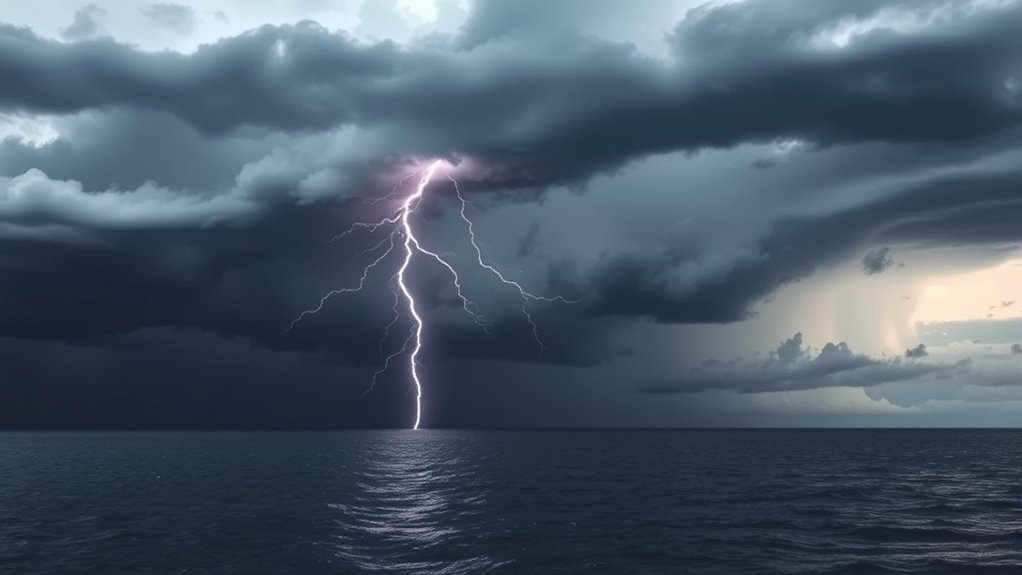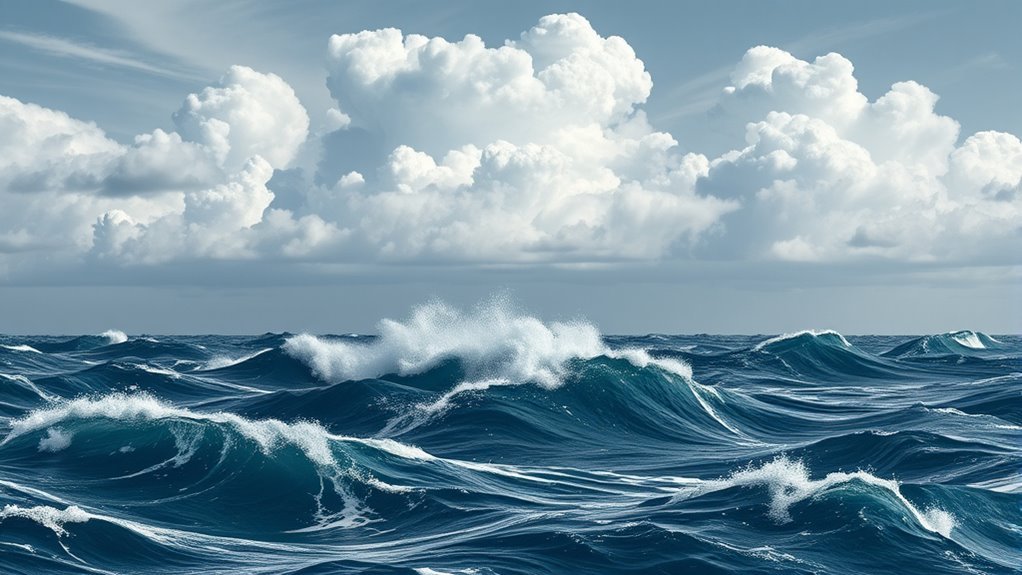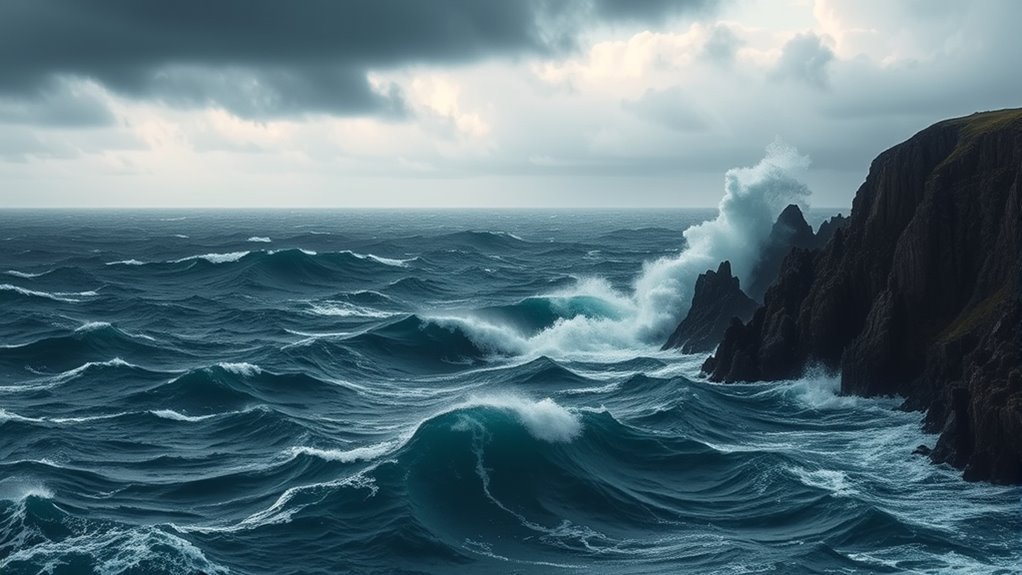Squalls cause rapid shifts in air currents due to intense wind bursts and downdrafts. These changes in speed and direction create turbulent conditions, impacting both local and broader wind patterns. The rotating nature of air during a squall results in complex interactions that alter established circulations. Consequently, squalls can complicate weather forecasting and affect navigation. Understanding these dynamics opens the door to revelations about their broader impacts on weather systems and climate.
Main Points
- Squalls generate rapid shifts in wind speed and direction, creating turbulent conditions in the atmosphere.
- Downdrafts from squalls push air downward and outward, leading to swirling wind patterns.
- Established wind patterns are altered, causing abrupt changes in local wind circulation.
- Sudden wind changes complicate weather forecasting and navigation for mariners and aviators.
- Increased turbulence from squalls impacts the stability of surrounding air masses, affecting overall air currents.
Understanding Squalls: Definition and Characteristics
Squalls are sudden, intense bursts of wind often accompanied by heavy precipitation. These meteorological phenomena can occur in various environments, ranging from coastal areas to open oceans. Typically, squalls manifest as a sharp increase in wind speed, often exceeding 20 knots, and are defined by rapid changes in weather conditions.
They may lead to a dramatic drop in temperature and visibility, making them particularly hazardous for mariners and outdoor enthusiasts. The duration of a squall is usually short-lived, lasting from a few minutes to half an hour.
Nevertheless, their impact can be considerable, influencing local weather patterns and air currents. Squalls are often associated with thunderstorms but can also arise from other weather systems.
Understanding the nature and traits of squalls is essential for predicting their potential effects on air currents and general atmospheric conditions, emphasizing their role in dynamic weather scenarios.
The Formation of Squalls and Their Triggers

When atmospheric conditions become unstable, squalls can develop due to a combination of factors such as temperature differentials, moisture availability, and wind shear. These phenomena typically arise when warm, moist air rises rapidly, colliding with cooler, denser air.
The presence of a weather front, particularly cold fronts, improves this interaction, creating a dynamic environment conducive to squall formation.
Additionally, localized heating from the sun can exacerbate instability, leading to the development of convective currents. The convergence of winds from different directions intensifies this instability, further promoting squall activity.
Moisture, often sourced from bodies of water, plays a critical role in fueling the storms, as it increases the likelihood of precipitation and turbulence.
In general, the interplay of these atmospheric elements creates the conditions necessary for squalls, which can manifest suddenly and with intense force, impacting both local weather and air currents considerably.
The Role of Squalls in Local Weather Patterns
Squalls considerably influence local weather patterns through their formation mechanisms and subsequent effects on temperature.
These sudden weather events can create sharp contrasts in temperature, leading to increased variability in local climates.
Understanding the dynamics of squalls is essential for predicting their impact on surrounding weather systems.
Squall Formation Mechanisms
Understanding the mechanisms behind squall formation is essential, as they greatly influence local weather patterns.
Squalls typically arise from the convergence of warm, moist air and cooler air masses, creating instability in the atmosphere. As the warm air rises, it cools and condenses, forming clouds and precipitation. The resulting downdrafts can lead to gusty winds, which contribute to the squall's intensity.
Additionally, factors such as topography and sea breezes can improve squall formation by altering local wind patterns. The interaction of various meteorological elements—including pressure gradients and temperature differentials—plays a critical role in the development and behavior of squalls.
Understanding these mechanisms provides significant revelations into predicting their occurrence and impact on local weather systems.
Impact on Temperature Variability
The influence of squalls on local temperature variability is substantial, as these weather events can lead to abrupt changes in atmospheric conditions.
Squalls can cause notable temperature fluctuations that impact local climates and ecosystems. Their rapid onset and intensity can alter prevailing weather patterns, creating a variety of effects, including:
- Sudden Cooling: A squall can bring cooler air, resulting in immediate drops in temperature.
- Increased Humidity: Associated precipitation raises local humidity, affecting temperature perception.
- Thermal Inversions: Squalls can disrupt normal temperature gradients, leading to unusual weather phenomena.
- Microclimate Changes: Localized squall activity can create distinct microclimates, influencing flora and fauna.
These dynamics illustrate the complex role squalls play in shaping local temperature variability and weather patterns.
How Squalls Influence Air Currents

While short-lived but intense weather events can disrupt established atmospheric patterns, squalls uniquely influence air currents by introducing rapid shifts in wind speed and direction. These abrupt changes can create turbulent conditions, leading to noteworthy alterations in local air movement.
As squalls develop, they often generate downdrafts that push air downward and outward, displacing surrounding air and causing it to swirl unpredictably. This turbulence can improve mixing in the atmosphere, affecting the dispersion of pollutants and the distribution of heat.
Moreover, squalls can initiate secondary wind patterns as the surrounding environment adjusts to the sudden changes. The interactions between the squall-generated winds and existing currents can result in complex flow dynamics, which may extend beyond the immediate area of the squall.
In the end, the influence of squalls on air currents plays a critical role in weather forecasting and understanding local meteorological phenomena.
The Impact of Squalls on Wind Circulation

Squalls considerably alter wind patterns, leading to abrupt changes in local circulation.
These short-term wind effects can disrupt established airflow, resulting in increased turbulence and variable wind speeds.
Understanding these impacts is essential for predicting weather conditions and steering air travel safely.
Squalls and Wind Patterns
When atmospheric instability occurs, squalls can greatly alter established wind patterns, leading to dramatic shifts in local air circulation. These sudden changes can impact various meteorological phenomena and contribute to the comprehensive dynamics of the atmosphere.
Key effects of squalls on wind patterns include:
- Rapid Wind Speed Changes: Squalls can cause abrupt increases in wind speed, affecting both surface and upper-level winds.
- Directional Shifts: Wind may change direction suddenly, complicating weather forecasting and navigation.
- Formation of Downdrafts: Intense squalls can create downdrafts, which influence the stability of surrounding air masses.
- Local Turbulence: The interaction of squalls with existing wind currents can lead to increased turbulence, impacting aviation and marine activities.
Understanding these impacts is essential for predicting weather-related hazards.
Short-term Wind Effects
Although squalls can be brief, their impact on wind circulation is considerable and immediate. These sudden bursts of intense wind often lead to rapid changes in local air pressure, resulting in shifts in prevailing wind patterns.
The turbulence generated by squalls can create erratic gusts, markedly altering the behavior of surrounding air currents. As squalls pass, they can induce a phenomenon known as wind shear, where layers of air move at different velocities.
This short-term disruption can affect the stability of the atmosphere, influencing weather systems beyond the immediate area. Additionally, the aftermath of a squall often includes a temporary increase in wind speed, which can contribute to further atmospheric mixing and influence subsequent weather conditions.
Squalls and Their Effects on Climate Systems
As atmospheric disturbances defined by sudden, intense wind shifts, squalls can remarkably influence local and regional climate systems. Their rapid onset and varying intensity can have several notable effects, including alterations in precipitation patterns and temperature variations.
Understanding these impacts is vital for predicting weather-related events and their broader climatic consequences.
- Precipitation Redistribution: Squalls can lead to sudden heavy rain, which may cause localized flooding but can also improve soil moisture in arid regions.
- Temperature Fluctuations: The intense winds can alter temperature profiles, leading to abrupt cooling or warming in affected areas.
- Air Quality Changes: Wind shifts can disperse pollutants more effectively, influencing air quality and health outcomes.
- Storm Development: Squalls can act as precursors to larger storm systems, potentially intensifying adverse weather events.
These elements underscore the importance of squalls in understanding climate dynamics.
Future Research Directions on Squalls and Atmospheric Dynamics
Understanding the impacts of squalls on climate systems sets the stage for exploring future research directions in atmospheric dynamics. Researchers are increasingly focusing on the interactions between squalls and larger weather patterns, as these phenomena influence regional climate variability.
Future studies may investigate the microphysical processes within squalls, examining how varying temperature and humidity levels affect precipitation and wind patterns.
Additionally, the role of squalls in enhancing or diminishing the intensity of storms presents a critical area for investigation. The integration of advanced modeling techniques, such as high-resolution simulations, could yield knowledge into the spatial and temporal evolution of squalls.
Moreover, interdisciplinary approaches combining meteorology, oceanography, and environmental science could provide a comprehensive understanding of squalls' effects on ecosystems.
As climate change continues to alter atmospheric conditions, understanding squalls will be essential in predicting their impact on future weather patterns and climate resilience.
Common Questions
How Do Squalls Affect Aviation Safety and Operations?
Squalls considerably impact aviation safety and operations by causing sudden changes in wind speed and direction. Pilots must remain vigilant, as these conditions can lead to turbulence, reduced visibility, and challenges during takeoff and landing.
Can Squalls Be Predicted Accurately in Advance?
The accuracy of squall predictions remains a challenge. Meteorologists utilize advanced technology and models to forecast their occurrence, yet unpredictability often complicates efforts, leaving pilots and operators to rely on real-time observations and alerts.
What Tools Are Used to Monitor Squalls in Real-Time?
To monitor squalls in real-time, meteorologists utilize advanced radar systems, satellite imagery, and weather buoy data. These tools provide critical information about storm development, intensity, and movement, enabling timely alerts and safety measures for affected areas.
Are There Any Historical Events Caused by Significant Squalls?
Notable historical events linked to squalls include the 1780 Great Hurricane, which caused widespread devastation in the Caribbean. Such storms have historically impacted maritime activities, leading to loss of vessels and lives due to unexpected weather changes.
How Do Squalls Differ From Thunderstorms and Hurricanes?
Squalls are brief, intense wind events often associated with rain, differing from thunderstorms, which involve lightning and thunder, and hurricanes, defined by sustained strong winds, extensive rain, and long-lasting impacts over larger areas.

